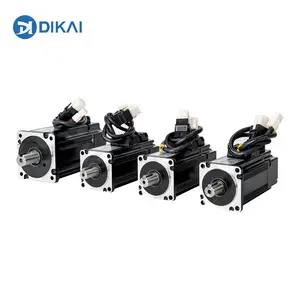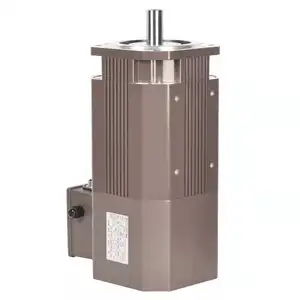(173059 products available)

























































































































































































































































AC servo motors are categorized into distinct types based on construction and application requirements. The key differences lie in stator and rotor designs, which define operational characteristics. Each type, however, offers unique advantages suited for diverse industry-specific needs and applications.
Synchronous AC servo motors rely on permanent magnets embedded in the rotor to create a magnetic field. This feature ensures that the motor rotates in synchronization with the supply current's frequency. As a result, these motors provide high precision and torque, making them ideal for CNC machines, robotic arms, and precision automation equipment.
Asynchronous motors, also called induction motors, operate on a different principle. They do not use permanent magnets in the rotor but instead rely on electromagnetic induction to produce motion. This feature makes them robust and reliable, particularly in harsh industrial settings. These motors are also preferred when high durability and lower maintenance requirements are needed.
These motors have a rotor that rotates at the same speed. An asynchronous motor's rotor does not necessarily need to match the magnetic field speed. It only needs to come close, which is fine during startup. After the motor reaches a specific speed, the rotor will sync with the field. Synchronization, therefore, happens at full speed.
Synchronous motors are often used for precise speed applications. They provide a constant speed value, even when the load varies. This feature allows them to be used in clock drives, shaft drives, and flip-flops, where the driving of other machinery components takes place.
AC servo motors find expansive industrial applications due to their high accuracy, efficiency, and reliability. They also ensure precise control in various automated processes. Here are key areas where these motors play a critical role.
Robotic systems require smooth and accurate motion control. Often, it is to perform complex tasks impeccably. AC servo motors provide the required precision in positioning and movement. This feature makes them indispensable for robotic arms used in assembly, welding, painting, and material handling. Furthermore, their ability to maintain torque at high speeds enhances the efficiency of robotic operations.
Synchronization and precision are crucial for CNC machines. They directly impact the accuracy of cutting, milling, and drilling operations. AC servo motors make this possible by delivering precise control over the machine's movements. This feature results in high-quality finished products. Additionally, investing in these motors improves energy efficiency.
The packaging industry relies heavily on automation to meet production demands. In this case, AC servo motors enable precision in label application, filling, sealing, and palletizing. Their ability to provide feedback means that processes will always be optimized in real time. It helps minimize waste and enhances the speed and accuracy of packaging operations.
The aerospace sector commonly relies on servo motors for critical applications. These motors offer the necessary reliability and precision required in flight control systems and actuators. Therefore, any slight deviation in this industry can result in dangerous outcomes. It is why the precision provided by AC servo motors is necessary during the maneuver of aircraft components.
Textile manufacturing also benefits from the use of AC servo motors. These motors help control weaving, knitting, and fabric cutting machines. Moreover, the motors enhance process control and reduce energy consumption. They also allow integrated electronic control. It improves material handling and machinery management.
What makes AC servo motors suitable for most applications are their enhancing and defining features. Here is a rundown of these features.
One of the most noticeable features of AC servo motors is their feedback mechanism. Normally, it comprises encoders that provide position, speed, and torque information. The information is used to make precise adjustments to motor output. This feature enables exact position control. Hence, these motors are ideal for applications where minor deviations can significantly impact the end product.
Most AC servo motors operate under a closed-loop control system. Here, the control system adjusts motor output based on feedback from the output. This adjustment ensures the motor operates at desired parameters even when there are variations in the load or system conditions. This feature greatly enhances the motor's reliability during operation, especially in dynamic environments.
AC servo motors provide high torque at a broader speed range than their DC counterparts. This feature makes them capable of handling heavy loads at varying speeds. Often, this is done without a drop in performance or efficiency. That is why they are suitable for industries requiring powerful and sustained operation.
AC servo motors function without brushes in the rotor. It is a critical element in asynchronous motors. It results in less friction and wear during operation. It also means these motors provide extended service life and reduced maintenance requirements. Its one advantage makes AC servo motors preferred in heavy-duty industrial applications where maintenance accessibility is low.
AC servo motors feature compact designs despite offering robust performance. Often this space-saving feature is integrated with advanced technology components. Hence, these motors can easily fit into tight spaces in automated machinery. Their compactness ensures that industries do not sacrifice limited space for operational efficiency.
Selecting the right AC servo motor is critical to optimizing operational efficiency. Below are important factors that will ensure clients' needs are catered to.
The first thing to consider when inquiring about clients' needs is their application requirements. It will reveal what role the servo motor will play in the respective application. For instance, industries dealing with robotics will need a motor that offers precise control. On the other hand, applications using CNC machines will require a motor that provides high torque and speed.
Precision in torque and speed specification must be looked at. Ideally, the motor's torque range should correspond with the application's load requirements. Also, the speed must match the desired operation rate. Rarely, should the motor's peak torque capabilities be above the maximum load torque to prevent motor stall.
Clients may buy AC servo motors separately. But they must also control with a motor controller to work effectively. That is why ensuring compatibility between the motor and controller is key. For example, the controller should offer the required modes of operation. They range from position, velocity, and torque control. It will ensure accurate and responsive motor performance.
The power rating of the middle should also be taken into consideration. It needs to be matched to the power supply available in the client' application. The common ratings include watt and horsepower. Getting them matched ensures operational efficiency. Mismatched ratings increase the risk of motor underperformance or overheating.
It can't be stressed enough that knowing the load with induction is vital. Mainly, it is because it affects the selection of AC servo motors. So, to begin, clients should first consider the type of load. Is it constant, or will there be a fluctuation? Also, the motor should handle the maximum load without losing performance. Lastly, clients' systems must be equipped with a proper brake system if they require mechanical brakes.
A1.Yes, manufacturers in industries that require high precision control benefit the most from synchronous AC servo motors. They are commonly used in CNC machines, robotics, and automated assembly lines. These motors are designed to provide high accuracy and torque, making them ideal for precision machining and automated handling tasks.
A2.The most common brushless DC motors and AC synchronous motors. The two can be controlled to provide precise position, velocity, and torque output. They, therefore, offer advantages such as higher efficiency, lower maintenance, and improved performance over traditional brushed DC motors.
A3.Selection factors like load-carrying capacity, speed requirements, and environmental conditions one should consider. The motor's torque curve should also be considered. It will ensure the motor can handle peak loads without stalling. And most importantly, ensure compatibility with existing system components.
A4.Indeed, it is looking bright and promising mainly because of the rapid industrial automation and the Internet of Things (IoT). Many industries are automating to reap electronic control, increased productivity, and decreased operational costs benefits. It is why demand for these motors is increasingly becoming a necessity since they are vital for robotic control, CNC machinery, and automated assembly lines.